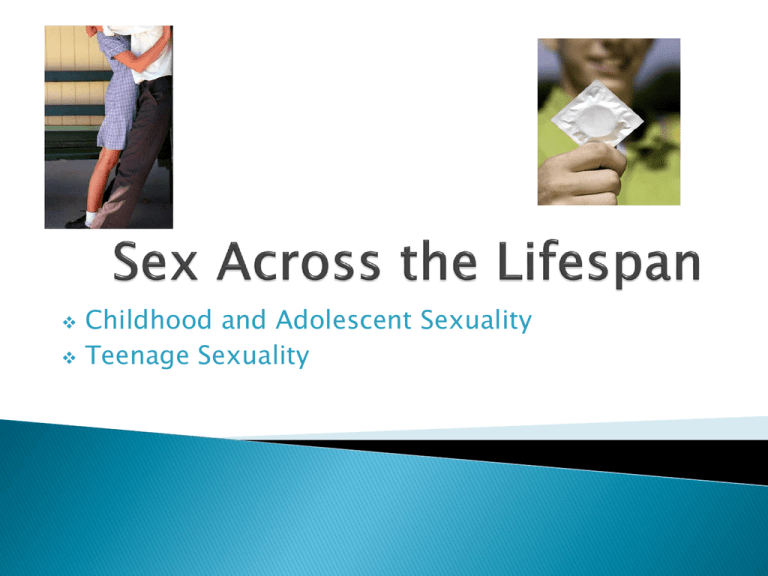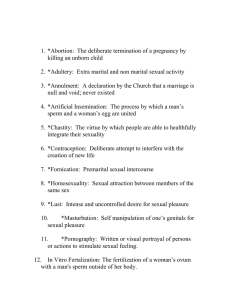
Childhood and Adolescent Sexuality
Teenage Sexuality
Infancy (0-2 years):
Self-stimulation-
◦ Infants have been observed fondling their own genitals.
Infant-infant sexual encounters-
◦ May kiss, hug, pat, stroke and gaze at each other.
Nongenital sensual experiences:
◦ Sucking on a mother’s breasts
◦ Sucking on his or her own fingers
◦ Being cuddle or rocked can also be sensuous
Attachment◦ Psychological bond that forms between an infant
and the mother, father, or other caregiver.
Knowing about boy/girl differences:
◦ At first infants think the difference between girls
an boys is a matter of clothes or haircuts.
◦ By age 3 there is increasing interest in the
genitals of other children.
Early Childhood (0-7 years):
Masturbation
◦ Learns that masturbation is something that one
does in private.
Heterosexual behavior
◦ “Playing doctor” can be popular.
Same-gender sexual behavior
◦ Sexual play with members of one’s own gender
may be more common than sexual play with
members of the other gender.
Sex knowledge and interests:
◦ Begins to have notion of genital differences
between males and females
◦ Enjoys hugging and kissing parents
◦ Becomes more modest at age 5
◦ Restriction on conversation about sex comes at
precisely the same time child is becoming more
aware of, and curious about, sexuality.
Preadolescence (8-12 years):
Masturbation
◦ More and more children gain experience.
◦ Boys learn from peers and from reading.
◦ Girls learn through accidental self-discovery.
Heterosexual behavior
◦ Very little because of the social division of males and
females into separate groups.
◦ Children commonly hear about sexual intercourse for the
first time.
Same-gender sexual behavior:
◦ Social organization is essentially homosocial
(boys play separately from girls)
◦ Same-gender sexual activities may involve
masturbation, exhibitionism, and fondling of
other’s genitals.
◦ Many lesbian, gay, and bisexual youth report
their first experience of sexual attraction at age
10 or 11.
Dating:
Around ages 10 or 11, children begin to spend
time in mixed-gender or heterosocial groups.
◦ The first romantic or sexual behaviors often
occur in this context.
Dating emerges in the seventh grade.
Romantic dyadic relationships involve a small
percentage of youth.
In some cultures, boys and girls are married at age
13.
Masturbation:
There is a sharp increase in the incidence of masturbation for
boys between ages 13 and 15.
Girls also begin masturbating in adolescence, but the
increase in behavior is much more gradual and continues past
adolescence.
Was once believe to cause everything from warts to insanity,
but current attitudes are more positive.
Same-gender behavior
◦ About 10% of college men and 6% of
college women report having had one
homosexual partner in high school.
Heterosexual behavior
◦ More and more young people engage in
heterosexual sex with more and more frequency.
◦ Over four years, there is a regular progression
from kissing, through French kissing and
fondling, to intercourse and oral-genital contact.
How many people have premarital intercourse?
◦ 70% of females
◦ 78% of males
First Intercourse - major transition with
psychological and social significance
Fewer men have premarital sex with a prostitute
than in the past.
Techniques in premarital sex include increased use
of oral-genital contact.
Attitudes toward Premarital Intercourse:
Abstinence
Permissiveness with affection
Permissiveness without affection
Double standard
◦ Wrong for males and females regardless of the circumstances.
◦ Permissible for males and females if it occurs in a stable
relationship of love, commitment, or being engaged.
◦ Permissible for males and females, regardless of emotional
commitment, simply on the basis of physical attraction.
◦ Acceptable for males but not for females.
Abstinence:
In one recent survey, 74 percent of teens ages 15
to 17 said they had “made a conscious decision to
wait.”
In some surveys, high intelligence is associated
with postponing intercourse and delaying other
partnered sexual activities.
Some schools and community-based programs
campaign to persuade teens to publicly sign
virginity pledges.
Motives:
Love
Physical arousal and pleasure
Peer pressure
Women are more likely to mention love and
affection.
Men mention physical pleasure.
Dating and going steady occurs at younger ages.
Serial monogamy - while in a relationship, the partners are
monogamous; when relationship ends, partners move on to
another partner.
Conflicts:
◦ Between restrictive sexual ethic and permissive one
◦ Between parents and children
◦ Between behaviors and attitudes or standards


